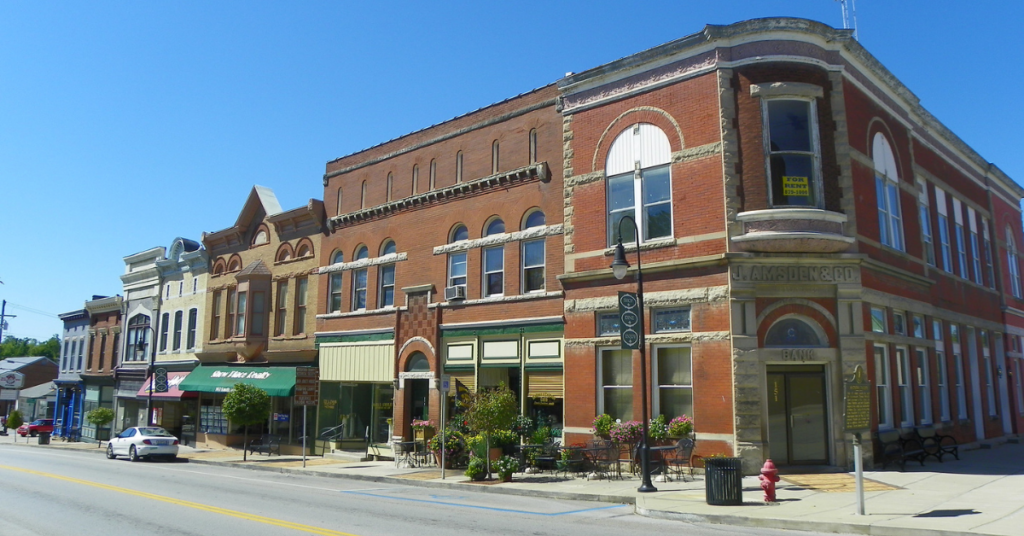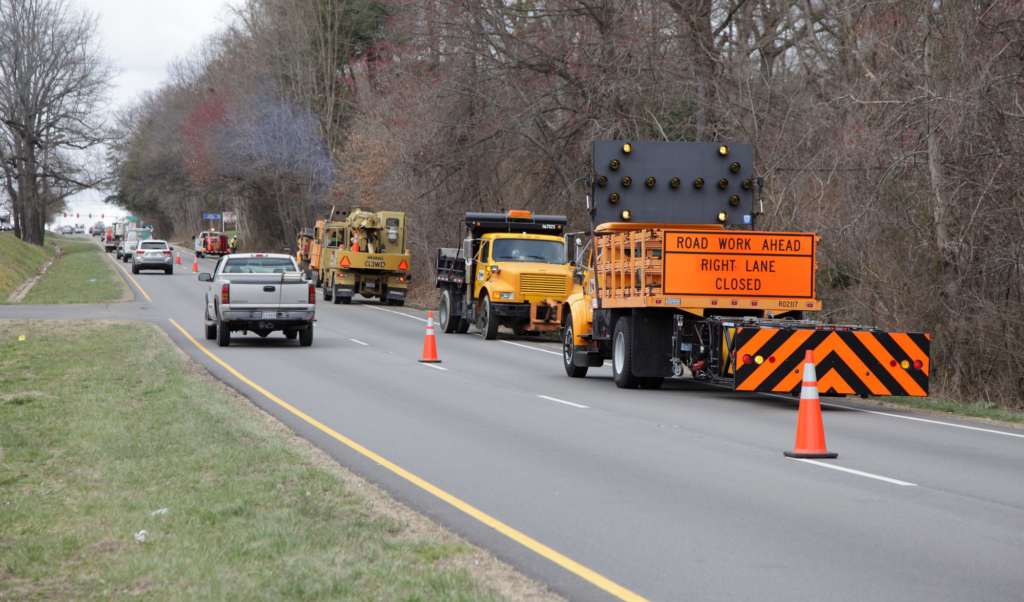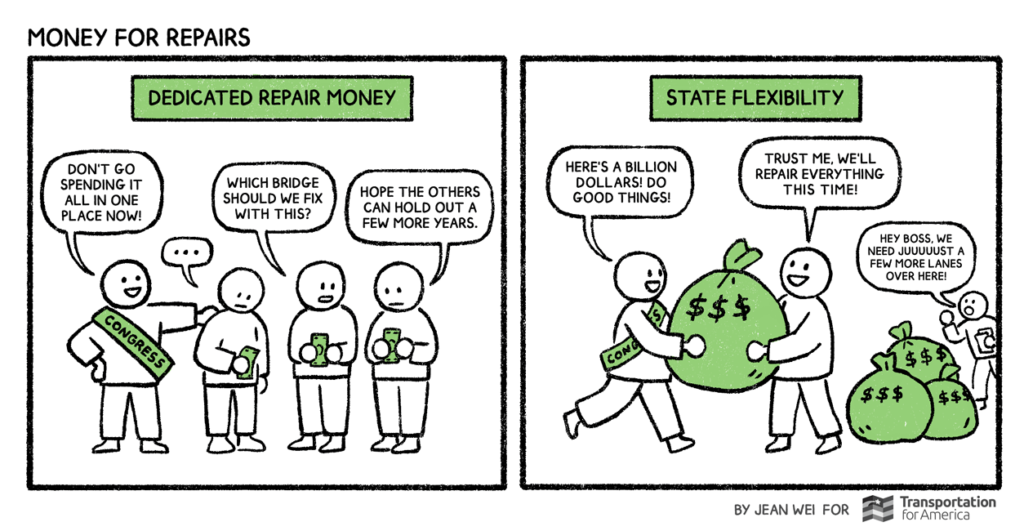
Fix it first in practice

One of our recently launched principles, fix it first, targets maintenance over expansion, advocating for federal highway dollars to be spent repairing old roads and bridges before expanding or building new ones. So, what would it look like in practice to implement this principle into the federal transportation program, to shift our states’ priorities away from grand openings and toward more resilient transportation infrastructure?

The problem
Make no mistake, requiring repair and maintenance before expansion would represent a complete reorientation of our transportation program. While some states certainly do better than others, the majority of them are ignoring or deprioritizing certain maintenance needs in favor of building new roads. And arguably none are creating long-term plans for financing the ongoing maintenance of those new roads or bridges. Which is why every five years, we hear the same rhetoric about why we need a massive increase in federal transportation investment to “fix our crumbling roads and bridges,” and why conditions rarely change. It’s a loop cycle.
A few years ago, before the passage of the 2021 five-year infrastructure law (the IIJA), we heard endless speechifying on Capitol Hill about the decaying infrastructure. Thousands upon thousands of deficient bridges. Bad roads. Unfathomable backlogs of neglected maintenance and repair. But with that historic infusion of infrastructure money in hand from the IIJA, state DOTs and a collection of senators lost their minds that USDOT would even deign to suggest that repair be prioritized first with that money.
It shouldn’t be a revolutionary principle: Federal dollars should not be spent on new roads and bridges if our existing ones are at risk of or already breaking down. The need for this reprioritization primarily stems from the staggering lack of priority that maintenance has historically been given. Instead of fulfilling repairs, our dollars are spent on expansion, resulting in the overwhelming 830 billion-dollar maintenance backlog.
If you have a flat tire, you don’t take a cross-country road trip before getting the tire replaced. We should have the same approach to our transportation infrastructure. In this video, bridges in Fife, Washington and East Providence, Rhode Island had to be closed due to safety concerns after decades of delayed maintenance. The closures reduced traffic flows to local businesses, causing significant concerns amongst local business owners seeing their revenues dip. Delayed maintenance also impacts access to necessary resources, such as healthcare, and can exacerbate damages caused by natural disasters, reducing our resilience to extreme events. On the other hand, investing in repairs holds numerous opportunities to improve quality of life and increase economic growth. If we invested only $1 billion per year into resolving delayed maintenance, an estimated 13,000 direct and indirect jobs would be created.

Implementing the principle
To reorient our federal program around repair and maintenance we’ll have to get to the root of the problem: policy, the resistance of state DOTs and their elected leadership to this idea, and a mistaken belief that new roads and lanes are the only viable strategy to reduce congestion, connect people to opportunity, and create economic benefits.
Congress came close in 2020 during the run-up to what eventually became the IIJA. In the House of Representatives, a much stronger and superior five-year reauthorization proposal (the INVEST Act) included an amendment from Rep. Jesús “Chuy” García (D-IL) and Rep. Mike Gallagher (R-WI) that would have enshrined our ix-it-first principle into federal transportation policy. The amendment included three small but transformative changes to the bill:
- Require a maintenance plan for building new capacity.
- Require benefit-cost analyses (BCAs) on new capacity projects.
- Include a range of new performance measures in BCAs.
Although small, these changes would have ensured that our federal dollars were spent responsibly, that expansions would not crumble just a few decades after being built and that new capacity projects have considered a wide range of accurately predicted benefits.
Unfortunately, this and some of the other best parts of the superior INVEST Act were removed during negotiations with the Senate to produce the final 2021 Infrastructure Investments and Jobs Act (IIJA). This amendment is only one example that prioritizing maintenance is not an unpopular opinion, but it does happen to be less popular than a ribbon-cutting photo op. If state’s are going to prioritize spending on maintenance, it has to come from the top. As a former Mississippi DOT Commissioner told us a few years ago, left to their own devices, states will continue taking the blank checks to build new things. “If you want us to prioritize maintenance, then you’re going to have to tell us ‘you gotta do it!’”
Replicating the policies in the INVEST Act would be a good starting point, but the maintenance goals can be strengthened through a few other key details. The federal government could create strict requirements on deferred maintenance before states are permitted to utilize that funding for new builds. A strong example of this are transit formula funds, which currently prioritize funding maintenance over expansion. Furthermore, ties to federal dollars would require the federal government to develop stronger tracking methods on how state funds are being spent on maintenance. Additionally, the federal government should embed additional requirements to more accurately define the beneficiaries of expansion projects. Through stronger BCAs, the federal government can ensure that funds are being spent to improve the quality of life of those living in the communities near new projects.
So, why hasn’t this happened yet?
The longstanding myth that expanded roadways improve congestion has been debunked. Furthermore, expansion actually makes traffic worse. This idea is referred to as induced demand, and is an economic term that illustrates how an increased supply in something will make people want and/or use it more.
But most state DOTs still view expansion as the only tool in their toolbox, and are highly resistant to being good stewards if it comes at the expense of long-planned new highways and expansion projects. Shortly after the 2021 release of the IIJA, Federal Highway Administration Deputy Administrator Stephanie Pollack shared a memo gently urging states to prioritize repair over new capacity projects. As noted earlier, congressional reps carrying water for their state DOTs lost their minds at the humble suggestion (no requirement!) that they should prioritize repair. The outcry was so intense that USDOT had to recall the non-binding memo.
This controversy overshadowed the fact that their voters back home actually believe that repair is the best use of infrastructure dollars, as well as the fact that a majority also believe that new roads or lanes either don’t affect congestion or make it worse. (Focus groups we’ve conducted in the past have also shown that voters are shocked to discover that there are no requirements for repair first. Many assume there are.)
Now is the time for our federal government to ensure that our roads and bridges are in a good state of repair before expanding a system with insufficient plans to ensure it will stand the test of time.
It’s Fix It First Week
Click below to access more content related to our second principle for infrastructure investment, Fix it first. Find all three of our principles here.
-
Fix it first in practice
One of our recently launched principles, fix it first, targets maintenance over expansion, advocating for federal highway dollars to be spent repairing old roads and bridges before expanding or building new ones. So, what would it look like in practice to implement this principle into the federal transportation program, to shift our states’ priorities away…
-
We can’t afford to keep avoiding repair
When decision-makers fail to prioritize basic maintenance and repair, everyday Americans pay the price—in increased costs, increased time on the road, and suffering local economies. We can’t keep wasting taxpayer dollars without a clear plan to maintain what we’ve already built.
-
It’s time to stop expanding and start maintaining
To reshape our transportation system and address staggering maintenance needs, we must prioritize repairing existing infrastructure before expanding our roadways any further.



